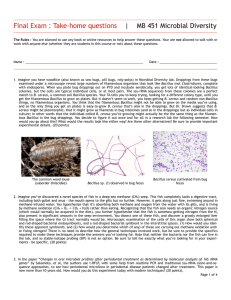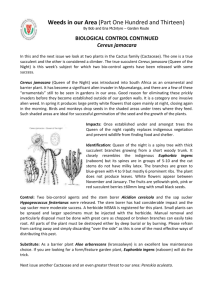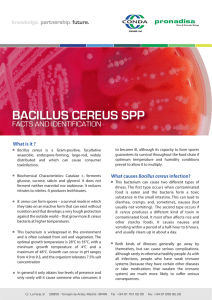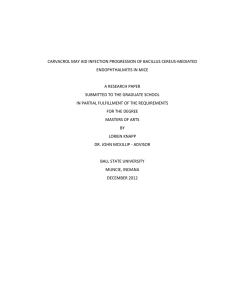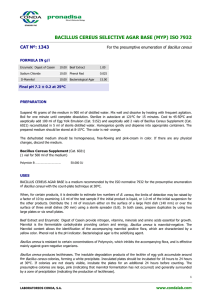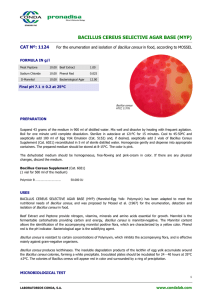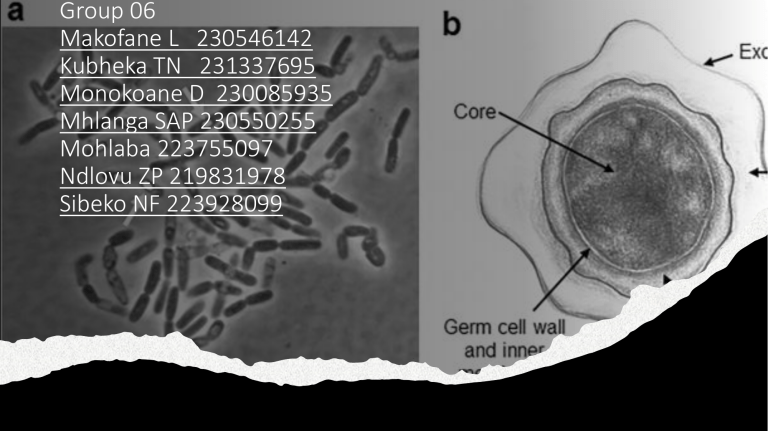
Group 06 Makofane L 230546142 Kubheka TN 231337695 Monokoane D 230085935 Mhlanga SAP 230550255 Mohlaba 223755097 Ndlovu ZP 219831978 Sibeko NF 223928099 Introduction • Bacillus cereus is a gram positive rod-shaped bactrerium commonly found in soil, food and marine sponges. • The specific name cereus, meaning ''waxy'' in Latin referes to the appearance of colonies grown on blood agar • Some strains are harmful to human which cause foodborne illness due to their spore-forming nature while other strains can be beneficial as probiotics for animals, and even exhibit mutualism with certain plants. • B. cereus bacteria may be anaerobes or facultative anaerobes and other members of genus Bacillus , can produce protective endospores. Morphology of bacillus cereus 1. Shape and size: • B. cereus cells are rod-shaped (bacilli) , about 0.51.0 micrometers wide and 2-3 micrometers long • They are Gram-positive, meaning that they have a thick cell wall that retains a violet stain during gram staining 2. motility: • Single polar flagellum that allows them to move 3. Spore formation: • They can form endospores that are resistant to many environmental conditions This Photo by Unknown author is licensed under CC BY-SA-NC. B. CEREUS: DISEASE AND SYMPTOMS Bacillus Cereus is a type of bacteria that can cause food poisoning and wound infection 1. B. Cereus Food poisoning : • Symptoms: Nausea, vomiting, abdominal pain, Diarrhea and fever • Treatment : Hydration, rest, antibiotics 2. B. Cereus Wound Infection : • Symptoms : Redness, swelling, pain. • Prevention: keeping wounds clean and covered, washing hands • Treatment : Antibiotics, draining of pus, depridement ( removal of dead tissue) Mode of transmission of B.Cereus B. cereus is primarily transmitted through food, but it can also transmitted through wounds - Food: undercooked riced, undercooked meat improperly refrigerated food. - Wounds: Contaminated surfaces, animal bites, and insects • Transmission occurs when contaminated food or surfaces come into contact with person's mouth or an open wound. Once inside the body, B.Cereus can multiply cause infection This Photo by Unknown author is licensed under CC BY. Preventative/Control methods of diseases cause B.Cereus There are several preventative and control methods that can be used to reduce the risk of B.Cereus infection. • These include: - Proper food handling and preparation: Proper cleaning , storage and cooking of food can help prevent the growth of B.cereus. - PPE: Proper personal protective equipment, such as gloves and hairnets, can help reduce the risk of contamination - Prompt treatment: If a person has symptoms of B.cereus Interesting Facts about B.cereus organisms • B.cereus is a spore-forming bacteria. - This means that it can form spores, which are hardy in structures that allow the bacteria to survive in harsh conditions - The spores of B. cereus can survive for years, making them a difficult contaminant to get rid of. - B. cereus is heat-resistant, and the spores can survive temperatures up to 121 °C This Photo by Unknown author is licensed under CC BY-NC-ND. - B. cereus is found all over the world, in many different environments, including soil, dust, and water


